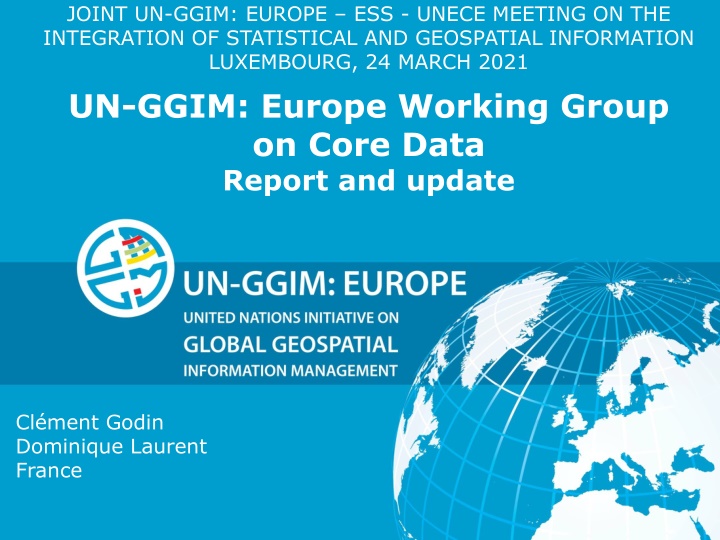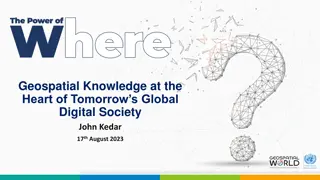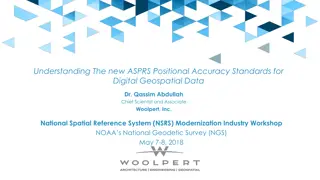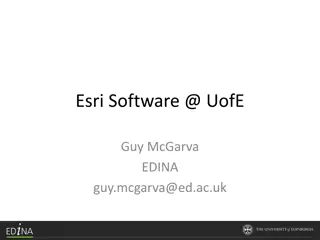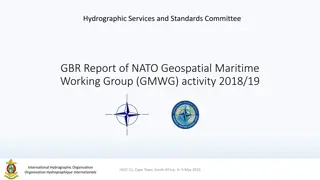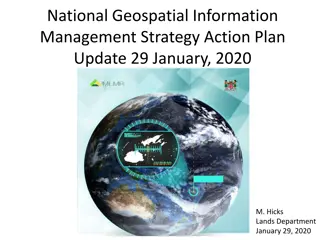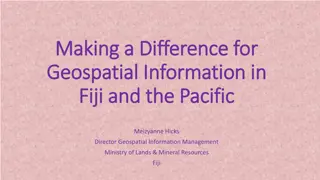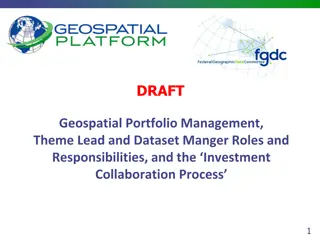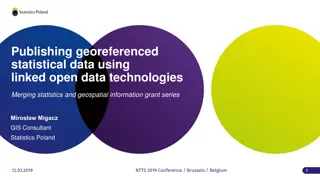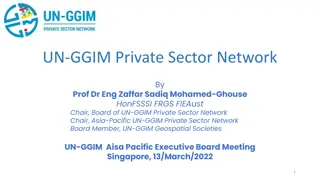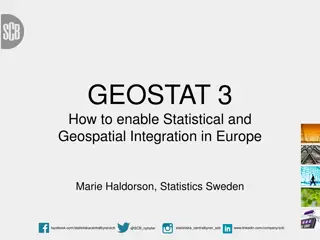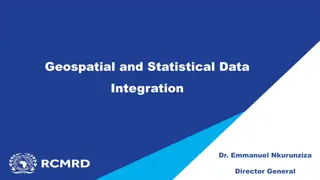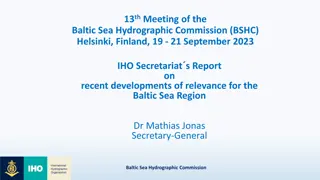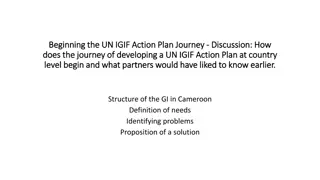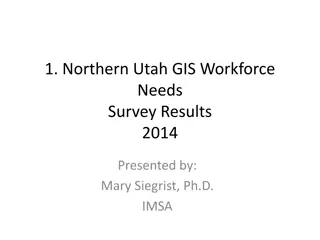Integration of Statistical and Geospatial Information - Meeting Highlights
General state of play and progress update from the UN-GGIM: Europe ESS-UNECE meeting on the integration of statistical and geospatial information in Luxembourg. Discussion on core data, high value datasets, global progress, and challenges in using land cover data for decision-making and assessment. Recommendations for ensuring continuity of data series like Corine Land Cover for effective analysis.
Download Presentation

Please find below an Image/Link to download the presentation.
The content on the website is provided AS IS for your information and personal use only. It may not be sold, licensed, or shared on other websites without obtaining consent from the author.If you encounter any issues during the download, it is possible that the publisher has removed the file from their server.
You are allowed to download the files provided on this website for personal or commercial use, subject to the condition that they are used lawfully. All files are the property of their respective owners.
The content on the website is provided AS IS for your information and personal use only. It may not be sold, licensed, or shared on other websites without obtaining consent from the author.
E N D
Presentation Transcript
JOINT UN-GGIM: EUROPE ESS - UNECE MEETING ON THE INTEGRATION OF STATISTICAL AND GEOSPATIAL INFORMATION LUXEMBOURG, 24 MARCH 2021 UN-GGIM: Europe Working Group on Core Data Report and update Cl ment Godin Dominique Laurent France
Table of contents 1. General State of Play 2. Core Data and High Value Datasets
Reminder Annex III Statistical units Buildings Soil Land use Human health and safety Utility and governmental services Environmental monitoring facilities Production and industrial facilities Agricultural and aquaculture facilities Population distribution - demography Area management/restriction/regulation Natural risk zones Atmospheric conditions Meteorological geographical features Oceanographic geographical features Sea regions Bio-geographical regions Habitats and biotopes Species distribution Energy resources Mineral resources Selected Core Data Themes Annex I Coordinate Reference Systems Geographical Grid Systems Geographical Names Administrative Units Addresses Cadastral Parcels Transport Networks Hydrography Protected Sites Annex II Elevation Land Cover OrthoImagery Geology
Global State of Progress Theme Analysis Decision making Draft Consolidated Draft After WG A Review Final Deliverable Deliverable After General Review AD AU The most advanced BU CP GN SU US AM OI Good progress EL TN HY LC In development LU
Progress on Land Cover LC are very useful data They deserve to be core data But it isnot reference data It is generalised data With different points of view Difficult to agree on common solution e.g. the INSPIRE model is very flexible 6
Progress on Land Cover LC data are often used to assess evolutions there is need for temporal series Corine Land Cover has been captured as different dates from 1990 Core recommendation is to ensure the continuity of CLC 7
Progress on Land Cover There is need for large scale data and trends to capture it Core data is proposing a flexible approach Recommendations about target product Target scale 1:10 000 or larger Whole partition of territory Recommendations about methodology Find national agreement about common product Separate LC and LU concepts (different products or different attributes) 8
Progress on Land Cover There are many evolutions regarding activities on Land Cover under lots of considerations for future New production methods (use of Sentinel data, VGI) Comparing or combining various LC-LU products Helping users to exploit new and complex LC products LC data and indicators Production of historical LC data Using other geometries (e.g. 3D) 9
Progress on Land Use Planned Land Use Kind of regulated zones Recommendations are very closed to the ones of theme Managed or regulated zones Main objective is to ensure easy access to data Mainly by digitalisation (if not yet the case) With the Land Use information in addition 10
Progress on Land Use Existing Land Use Core recommendation about large scale product With the same approach as for Land Cover Recommendations about target product Target scale 1: 10 000 or better Whole partition of territory Recommendations about methodology Find national agreement about common classification Ensure consistency between data specification and main source data 11
Overview Core Data High Value Datasets Data in scope of the Open Data Directive Article 14 Priority data for SDGs Key purpose UN-GGIM: Europe Regional Committee Working Group A European Union Impact Assessment Study: Cabinet Deloitte Actors Content description & recommendations for publication as open data (Impact Assessment Study) Recommendations for content Objective Geographic data Data on 6 categories Scope 13
Selection criteria High Value Datasets Core Data Generate significant socio- economic or environmental benefits Core Data is priority data to analyse, achieve or monitor SDGs and innovative services Generating innovative services is not a Core Data target (but it may contribute) Benefit a high number of users Core Data should in general be accessible to everyone In particular SMEs Main target is public bodies but SMEs may also benefit from Core Data Assist in generation revenues Generating revenues is not Core Data target Be combined with other datasets Combined with other datasets, core geographic data offer wide range of applications: background map, geocoding, indicator computation
Comparison exercise Source documents For High Value Datasets, impact assessment study and presentations by Cabinet Deloitte (PPT) Webinar on 28/07/2020 Review phase by Member States Webinar on 04/09/2020 For Core Data, UN-GGIM: Europe Working Group A deliverables Selection of core themes Recommendations for content for each selected theme 15
Comparison results (methodology) UN-GGIM: Europe Core Data HVD impact assessment study Rationale for choice Rationale for choice was investigated and published Rationale for choice not exposed Strong (preliminary list of potential themes, use of INSPIRE terminology) Weaker (other themes, terminology not always consistent) INSPIRE influence 2 levels 2 levels - - Lower intensity intervention Higher intensity intervention - - Core recommendations Good practices Priorities option to be chosen for regulation step-wise implementation 16
Comparison exercise (theme selection) prices SU AU GN AD BU CP finance trade Geospatial business tourism ... EL HY LC LU OI PS AM PD? HH? Statistics GE SO OF SR NZ EF Environmental data (noise, air quality, waste ) Companies BR SD HB Earth observation and environmental data Core data US - Basic servic es MF AC TN Mobility Meteorological INSPIRE 17
Analysis of selected HVD themes by the impact study Comparison with UN-GGIM Europe core data HVD has wider scope more themes Most of core data themes are considered as HVD Only 2 missing themes in HVD Statistical Units (but some overlap with administrative units) Basic services Difficult to evaluate HVD selection as rationale is not exposed in the impact assessment study 18
Zoom on Statistics category INSPIRE theme SU not included in HVD ESS data sets (already freely available) List of HVD datasets Unclear status of ESS data sets: in or out HVD? 20
Comparison exercise (priorities for EO data) First HVD priority is on specific data for environmental reporting whereas core data focus on basic data (INSPIRE themes) required by a wide range of use cases. 21
Comparison exercise (priorities for mobility) First HVD priority is on water transport network whereas core data includes rich information on road transport and more basic one on railway, water and air transport 22
Conclusions Core Data and HVD Different contexts and objectives Common principle for selection: wide use Some different points of view on EO and Mobility HVD impact study: candidate priority HVD is addressing dedicated data (e.g. to reporting for European Directives, to Water Transport) Core data is focusing on widely used data (e.g. richer model for data on road than on water transport) Most of UNGGIM core data is considered as high value data by the HVD impact study
Conclusion Final deliverables Available for 4 core themes Almost ready for 8 core themes Reflections on Land cover and Land use in progress Despite the health situation More than ever, the core data remains relevant In an European context (High Value Datasets)
